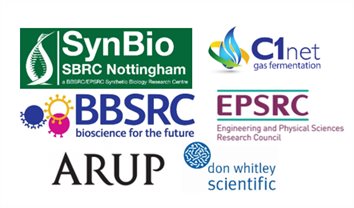SBRC - Nottingham Returns to New Scientist Live 2018
For the second year in a row, The Synthetic Biology Research Centre – Nottingham (SBRC) and its associated BBSRC NIBB - C1net hosted an exhibition stand which highlighted the great research we do here at the centre. The exhibition stand included an interactive computer model of a biochemical pathway displayed on an iPAD, developed by members of the SBRC computational team. This gave visitors the opportunity to decide how they would alter a metabolic pathway to produce the required end-product. Following from the success of having an anaerobic microbiology cabinet last year, Don Whitley Scientific very kindly loaned one of their anaerobic cabinets once again for us to display as part of our exhibition. We gave visitors an idea of what is like working in these cabinets through a fun task. This required them to transfer ‘knitted bacteria’ from falcon tubes into Petri dishes using tweezers against the clock!
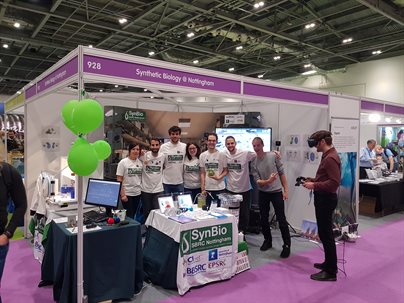
We developed a Raspberry Pi sequencer for NSL to demonstrate how we check DNA sequences for errors. With assistance from Dr Michael Wilson of the Advanced Data Analysis Centre (ADAC), programming languages Python and Java were used to convert data generated by coloured beads (representing DNA nucleotides) passing an LED and colour sensor into the corresponding 4-letter DNA sequence.
Then we had several display cases showing Petri dishes and microscope images of the bacteria we use in the SBRC, plus a mini-bioreactor to help us explain how fermentation processes could be scaled up. Accompanying this we had some examples of potential products, such as a model tyre and a fuel tank, to demonstrate where the C1 compounds could end up after the bacteria have converted them into useful chemicals.
“The new Scientist Live was a unique experience, as it offered the opportunity to communicate and explain the benefits of our scientific research to a wide range of people, aged between 9yrs and 40yrs. Not only were we able to inspire the young generation but also inform and address the concerns of many adults and older people. Of course such a huge event attracted people from different scientific fields, which gave us a good insight into what is happening in other universities and companies around the globe. I am really grateful for the opportunity to be part of the SBRC’s NSL team and I would definitely volunteer for that again.” Stylianos Grigoriou, SBRC PhD Student.
The final section of our stand was part of a collaboration set up with ARUP, a multinational professional services firm which provides engineering, design, planning and consulting services for aspects of the built environment. ARUP’s digital technical team designed a Virtual Reality Lab for us to use on the stand. Visitors were able to play the Virtual Reality demonstration and get the full feeling (visual and sound) of what it’s like to work in a lab, without having the risks of being in a full working lab environment. This included a serial dilution experiment and an explanation to why we do this technique as part of our synthetic biology research. With many people queuing up for this exhibit over the weekend, it was certainly a major draw to the stand.
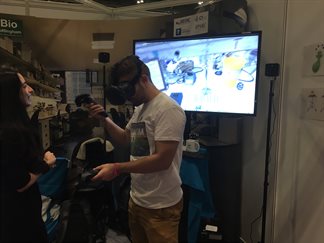
Over the 4 day event we were helped by many brilliant volunteers from the SBRC, who all demonstrated their enthusiasm and passion for science in their conversations as well as convincing possible sceptics about the benefits of our research. This was a great chance for them to inspire and motivate young people, adults and family audiences in which they all did an amazing job.
“New Scientist Live was an enjoyable and valuable experience, interacting with the public and talking about our work in the SBRC at a range of levels, from the very young to adults as well as more experienced and knowledgeable members of the public. I was very impressed with what our outreach team put together for the SBRC exhibit; a virtual reality lab experience, Don Whitley Scientific anaerobic cabinet and Raspberry pi benchtop sequencer which all drew large crowds. I was proud to be part of the team and to represent SBRC Nottingham at such a high profile event.” Dr Andrew Dempster, SBRC Post-Doctoral Researcher.
Another one of the highlights of the event was an amazing Cupriavidus necator bacterium costume (or Cooper as he was named) hand-made by SBRC post-doctoral researcher Dr Christian Arenas. This was a superb addition to the stand bringing in frequent curious visitors!! Many younger visitors were very interested in Cooper and Dr Christian explained that Cupriavidus necator is not a harmful bacteria but a helpful one which can turn waste gases into something useful!
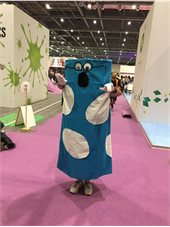
The event was extremely successful not only as a fantastic opportunity to highlight the wonderful cutting edge research taking place at SBRC–Nottingham but also for the researchers to raise public awareness and practice their science communication.
It was great seeing how people reacted when some of the things that might seem unreal and the products of imagination were mentioned. In some way we showed there that the weirdest ideas can come true with work and will. We, researchers, sadly live in a bubble difficult to break in the working environment. In my opinion, it is necessary to break it once upon a while, and these events are a perfect occasion for it. Seeing some of these surprised faces, especially the children’s, made the event worthy and left me a very good sensation at the end. Diego Orol Gomez, SBRC PhD Student.
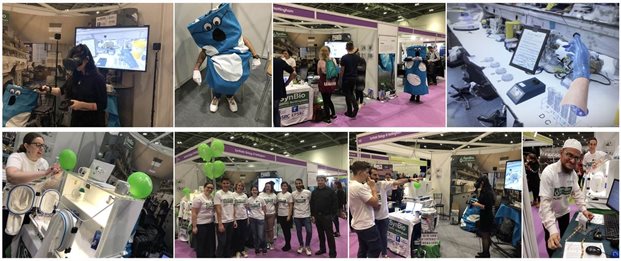
A very big special thanks goes to everyone involved in the organisation and delivery of this event including:
SBRC Committee Members: Louise Dynes (Project Manager), Dr Christian Arenas, Dr Ruth Cornock, Michelle Kelly and Dr Pippa Strong
SBRC Volunteers: Dr Andrew Dempster, Dr Muhammad Ehsaan, Stylianos Grigoriou, Diego Orol Gomez, Dr Patrick Ingle, Dr Carmen McLeod, Jacque Minton, Claudio Tomi Andrino and Federico Turco
Sponsors:
